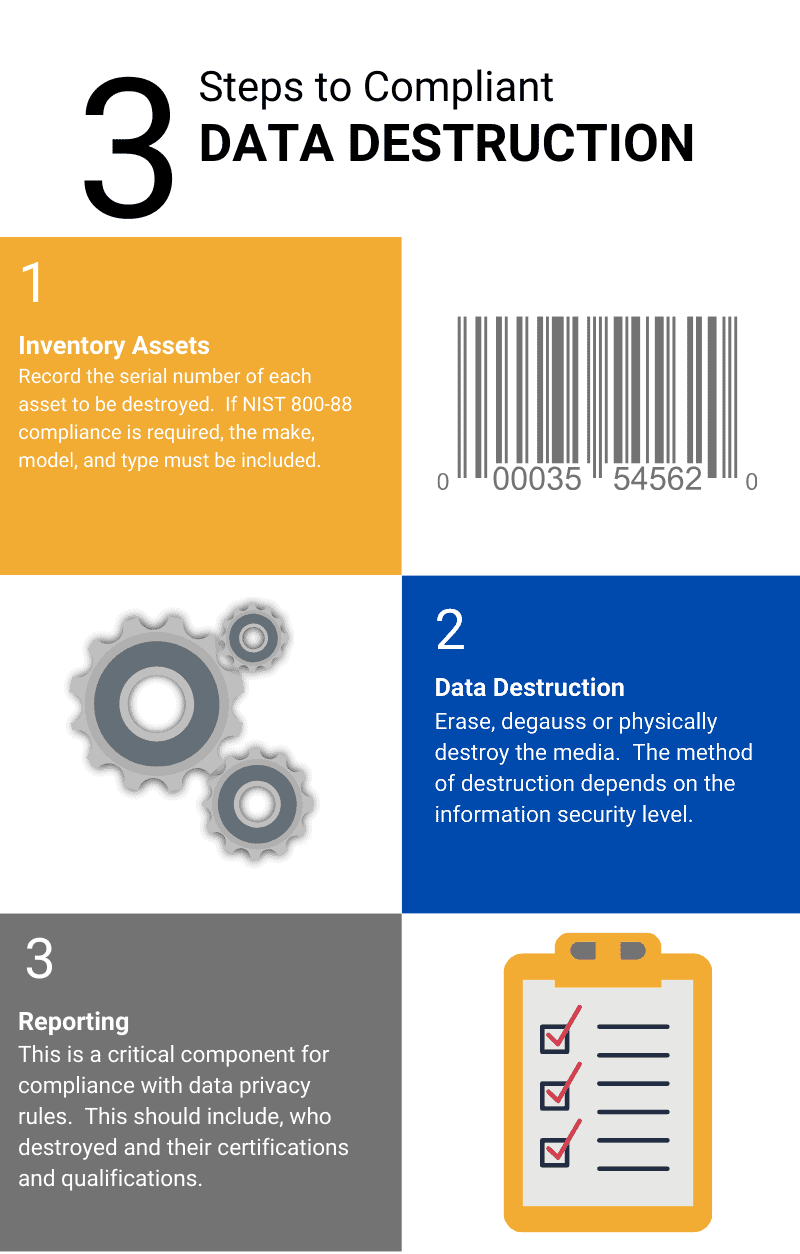How Robust Data Destruction Improves Your Overall Cyber Security Procedures
How Robust Data Destruction Improves Your Overall Cyber Security Procedures
Blog Article
Discovering the Significance of Information Devastation in the Context of Computer System Protection Services and Protecting Confidential Information
In a period where information violations are progressively usual, the importance of effective information damage can not be overstated. What approaches can companies implement to boost their data damage procedures?
Recognizing Data Destruction
Data destruction is a critical component of computer system safety and security that entails the long-term removal of information from storage gadgets to stop unapproved accessibility and potential data violations. In a progressively digital landscape, companies deal with heightened risks connected with sensitive information being poorly accessed or exploited. Reliable information destruction safeguards versus these risks, ensuring that confidential dataâEUR" such as consumer info, copyright, and financial recordsâEUR" can not be recouped after disposal.
Recognizing the relevance of information destruction prolongs beyond mere conformity with regulative and legal structures; it is crucial for maintaining organizational integrity and trust fund. When data is poorly managed or inadequately damaged, the consequences can be severe, consisting of financial loss, reputational damage, and legal liabilities.

Approaches of Data Obliteration

One common technique is data wiping, which entails overwriting existing information with random patterns numerous times. This technique makes the initial information irretrievable, making it a preferred choice for organizations seeking to shield private information.
An additional approach is degaussing, which uses a powerful magnetic area to interrupt the magnetic domain names on storage space gadgets, efficiently erasing the information. This method is particularly efficient for magnetic media however is not applicable to solid-state drives.
Physical destruction is one more durable method, involving the shredding or crushing of storage tools. This technique warranties that data recovery is virtually impossible, making it suitable for very sensitive info.
Lastly, security can work as a complementary approach to information eradication. By securing data before removal, companies can add an added layer of safety, guaranteeing that even if residues are recovered, they stay unattainable without the decryption trick. Each approach needs to be selected based upon the degree of data level of sensitivity and the details safety and security demands of the company.
Legal Conformity and Information Security
Organizations should navigate a complicated landscape of legal demands connected to information safety and security, specifically after implementing techniques of information elimination. Various policies, such as the General Information Security Regulation (GDPR) and the Health Insurance Policy Mobility and Liability Act (HIPAA), enforce rigid guidelines on just how companies should deal with and get rid of of sensitive data. Failure to comply with these laws can result in considerable lawful effects, consisting of substantial penalties and reputational damage.
Information damage processes should be meticulously recorded to show conformity with suitable laws and standards. This documentation not just functions as proof of adherence to lawful obligations yet likewise highlights a dedication to securing delicate information. Organizations should additionally establish clear plans regarding information retention and damage timelines, making sure that information is not held longer than necessary.

Additionally, normal audits and analyses of information devastation methods are vital to maintain compliance and adjust to developing lawful structures (data destruction). By proactively attending to legal requirements, companies can minimize threats associated with data violations and show their dedication to data protection. Eventually, focusing on lawful compliance in data destruction processes is not just a governing responsibility, but a fundamental facet of a durable information protection strategy
Influence On Company Reputation
The credibility of a company can be significantly impacted by its method to information destruction and management. In today's electronic landscape, where information breaches can take place at any minute, the failing to appropriately dispose of sensitive details can result in serious consequences. Organizations that inadequately manage information devastation threat subjecting private customer details, which not only goes against personal privacy legislations but likewise deteriorates depend on amongst stakeholders and clients.
A damaged credibility can result in lowered consumer commitment, as clients end up being go to this website hesitant to involve with an organization that has demonstrated negligence in safeguarding their information. In addition, unfavorable publicity bordering an information breach can have an enduring result, as possible consumers could be prevented by the viewed absence of safety. This can result in a straight decrease in revenue and market share.
In addition, companies that focus on data damage as part of their protection method can enhance their online reputation by showcasing their commitment to protecting delicate info. By adopting rigid data administration methods, organizations can not only minimize threats but likewise place themselves as reliable entities in their corresponding industries, therefore reinforcing their overall brand picture.

Best Practices for Secure Disposal
Carrying out ideal practices for safe disposal of information is vital for mitigating threats connected with data breaches and guaranteeing conformity with personal privacy policies. Organizations needs to take on a detailed data disposal plan that click over here lays out treatments for both digital and physical data devastation.
For physical data storage devices, such as hard disk drives, shredding or degaussing is recommended to avoid data recuperation. Furthermore, organizations ought to maintain a chain of guardianship documents throughout the disposal process, making certain liability and traceability of disposed products.
For digital data, utilizing software program that complies with market requirements for data wiping is essential. This software application must overwrite existing information several times, making healing essentially difficult. It is likewise vital to verify the efficiency of the information destruction process through audits or third-party evaluations.
Educating workers on protected disposal practices includes one more layer of security, as human error can often result in information direct exposure. Frequently reviewing and updating disposal plans makes sure placement with evolving laws and technical innovations. By applying these ideal practices, organizations can substantially decrease the risk of unapproved data accessibility and improve their total information security technique.
Verdict
Finally, information destruction is a fundamental aspect of computer security solutions that makes sure the protection of secret information from unapproved gain access to. Implementing efficient approaches of data eradication, adhering to lawful compliance, and acknowledging the influence on business track record are vital elements redirected here of a comprehensive information security technique. By embracing ideal methods for protected disposal, organizations can cultivate trust with customers and secure delicate information, ultimately contributing to an extra safe and secure electronic landscape.
In a period where data violations are progressively common, the significance of efficient data destruction can not be overemphasized.Data devastation is a vital part of computer system protection that involves the long-term elimination of data from storage gadgets to prevent unauthorized accessibility and possible information violations. Organizations needs to also establish clear plans concerning information retention and damage timelines, making certain that information is not held longer than needed.
By proactively dealing with lawful requirements, organizations can alleviate threats linked with data violations and demonstrate their dedication to data safety and security (data destruction). Inevitably, prioritizing lawful conformity in information devastation processes is not just a regulatory obligation, but a basic element of a robust data security approach
Report this page